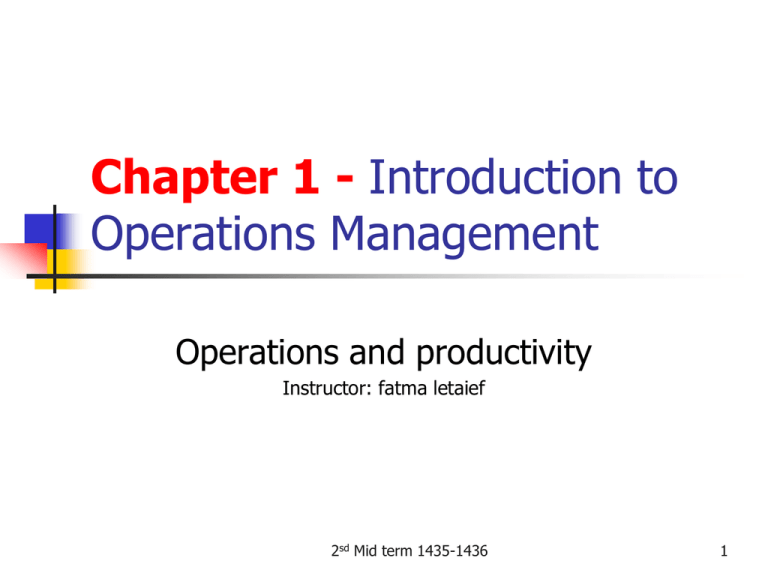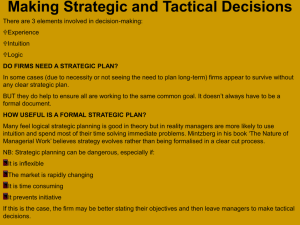320 نما المحور الاول
advertisement

Chapter 1 - Introduction to Operations Management Operations and productivity Instructor: fatma letaief 2sd Mid term 1435-1436 1 Learning Objectives Define Operations Management (OM) Explain the role of OM in business Describe the decisions that operations managers make Describe the differences between service and manufacturing operations Identify major historical developments in OM 2 Learning Objectives - continued Identify current trends in OM Describer the flow of information between OM and other business functions 3 What is Operations Management? The business function responsible for planning, coordinating, and controlling the resources needed to produce a company’s products and services 4 What is Operations Management? It is a management function Organization’s core function Every organization has OM function Service or Manufacturing For profit or Not for profit 5 Typical Organization Chart 6 What is Operations Management Role? OM Transforms inputs to outputs Inputs are resources such as People, Material, and Money Outputs are goods and services 7 OM’s Transformation Process 8 OM’s Transformation Role To add value Increase product value at each stage Value added is the net increase between output product value and input material value Provide an efficient transformation Efficiency – perform activities well at lowest possible cost 9 Differences between Manufacturers and Service Organizations Services: Intangible product Product cannot be inventoried High customer contact Short response time Labor intensive Manufacturers: Tangible product Product can be inventoried Low customer contact Longer response time Capital intensive 10 Similarities-Service/Manufacturers All use technology Both have quality, productivity, & response issues All must forecast demand Each will have capacity, layout, and location issues All have customers, suppliers, scheduling and staffing issues 11 Service - Manufacturing Manufacturing often provides services Services often provides tangible goods Some organizations are a blend of service/manufacturing/quasimanufacturing (QM) organizations QM characteristics include Low customer contact & Capital Intensive 12 Trends in OM Service sector growing to 50-80% of non-farm jobs- See Figure 1-4 Global competitiveness Demands for higher quality Huge technology changes Time based competition Work force diversity 13 OM Decisions All organizations are based on decisions Decisions follow a similar path First decisions very broad – Strategic decisions Strategic Decisions – set the direction for the entire company; they are broad in scope and long-term in nature Following decisions focus on specifics Tactical decision 14 OM Decisions Tactical decisions focus on Specific day-to-day issues Resource needs, schedules, & quantities to produce Tactical decisions are very frequent Strategic decisions less frequent Tactical decisions must align with strategic decisions 15 OM Decisions 16 Why OM? For long-run success companies must place much important on their operations The 1950-1960 era was the U.S. golden era where primary opportunities were marketing The 1970-1980 U.S. companies experienced a large decline in productivity growth – international firms began to challenge in many markets The 1970-1980 era saw U. S. firms lagging behind in methods and processes The resurgence of American business in the 1990’s capitalized on improved operations 17 Historical Development of OM Industrial revolution Late 1700s Scientific management Early 1900s Human relations movement 1930s to 1960s Management science Mid-1900s Computer age 1970s Environmental Issues 1970s 18 Historical Development of OM Time-Based Competition 1990s Supply chain Management 1990s Electronic Commerce 2000s Outsourcing and flattening of the world 2000s 19 Historical Development of OM Just-in-Time Systems (JIT) 1980s Total quality management (TQM) 1980s Reengineering 1990s Global competition 1980s Flexibility 1990s 20 Today’s OM Environment Customers demand better quality, greater speed, and lower costs Companies implementing lean systems concepts – a total systems approach to efficient operations Recognized need to better manage information using ERP and CRM systems Increased cross-functional decision making 21 OM in Practice OM has the most diverse organizational function Manages the transformation process OM has many faces and names such as; V. P. operations, Director of supply chains, Manufacturing manager Plant manger, Quality specialists, etc. All business functions need information from OM in order to perform their tasks 22 Business Information Flow 23 OM Across the Organization Most businesses are supported by the functions of operations, marketing, and finance The major functional areas must interact to achieve the organization goals 24 OM Across the Organization continued Marketing is not fully capable of meeting customer needs if they do not understand what operations can produce Finance cannot judge the need for capital investments if they do not understand operations concepts and needs Information systems enables the information flow throughout the organization Human resources must understand job requirements and worker skills Accounting needs to consider inventory management, capacity information, and labor standards 25 Productivity Measure of process improvement Represents output relative to input Units produced Productivity= Input used Only through productivity increases can our standard of living improve 26 Multi-Product Productivity Productivity = Output/Labor + material + energy + capital + miscellaneous 27 Measures of Productivity © Wiley 2007 28 Chapter 1 Highlights OM is the business function that is responsible for managing and coordinating the resources needed to produce a company’s products and services. Its role of OM is to transform organizational inputs into company’s products or services outputs OM is responsible for a wide range of decisions, ranging from strategic to tactical. Organizations can be divided into manufacturing and service organizations, which differ in the tangibility of the product or service 29 Chapter 1 Highlights continued A number of historical milestones have shaped OM. Some of the more significant of these are the Industrial Revolution, scientific management, the human relations movement, management science, and the computer age OM is highly important function in today’s dynamic business environment. Among the trends with significant impact are just-in-time, TQM, reengineering, flexibility, time-based competition, SCM, global marketplace, and environmental issues OM works closely with all other business functions 30





